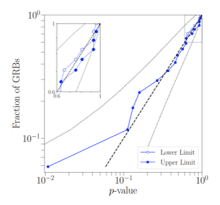
Abstract
We search for gravitational-wave signals associated with gamma-ray bursts detected by the Fermi and Swift satellites during the second half of the third observing run of Advanced LIGO and Advanced Virgo (1 November 2019 15:00 UTC–27 March 2020 17:00 UTC). We conduct two independent searches: a generic gravitational-wave transients search to analyze 86 gamma-ray bursts and an analysis to target binary mergers with at least one neutron star as short gamma-ray burst progenitors for 17 events. We find no significant evidence for gravitational-wave signals associated with any of these gammaray bursts. A weighted binomial test of the combined results finds no evidence for sub-threshold gravitational wave signals associated with this GRB ensemble either. We use several source types and signal morphologies during the searches, resulting in lower bounds on the estimated distance to each gamma-ray burst. Finally, we constrain the population of low luminosity short gamma-ray bursts using results from the first to the third observing runs of Advanced LIGO and Advanced Virgo. The resulting population is in accordance with the local binary neutron star merger rate.